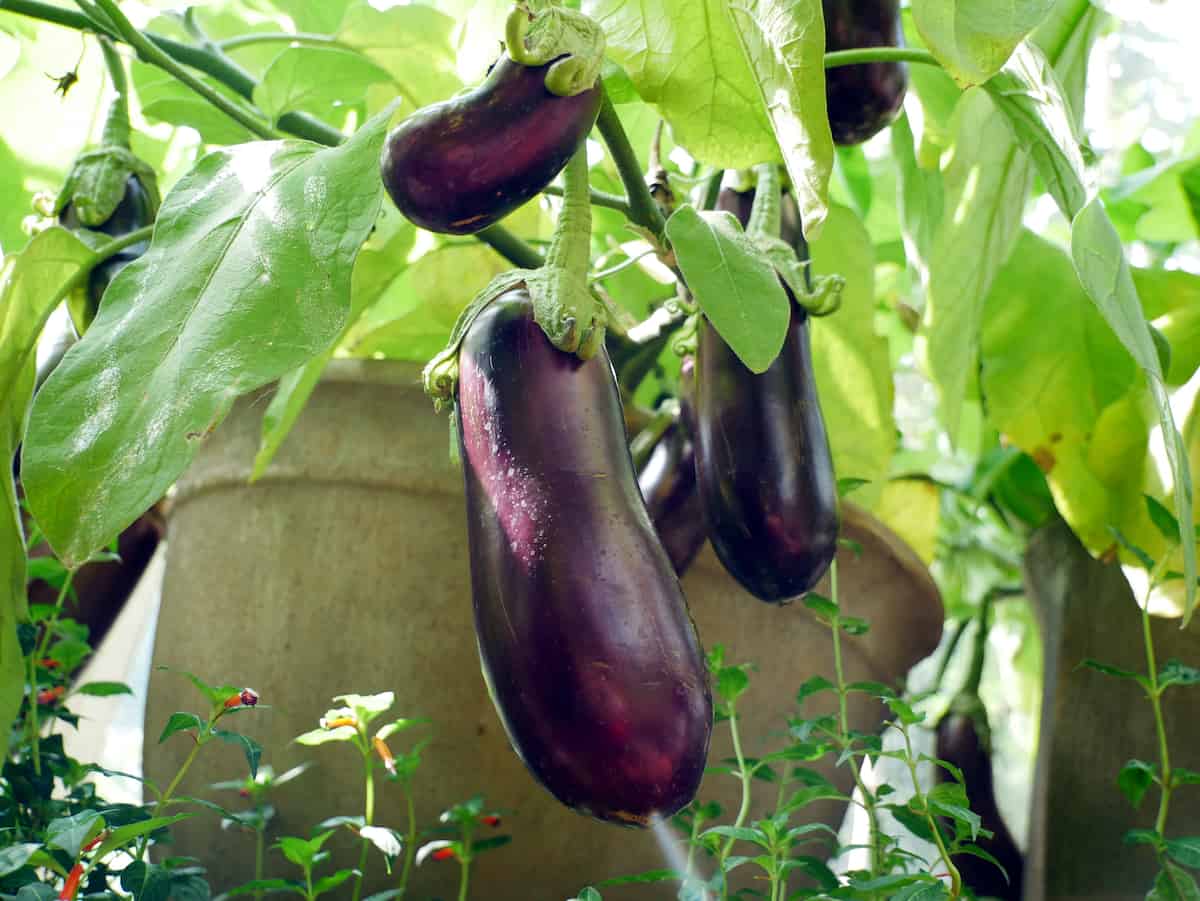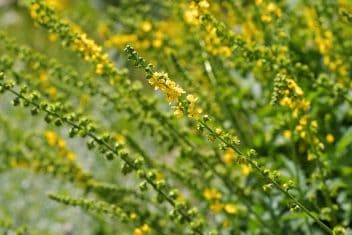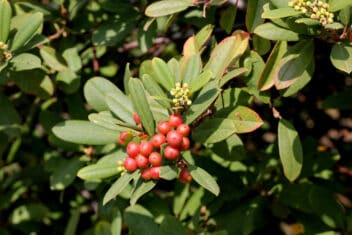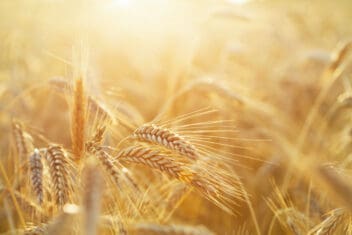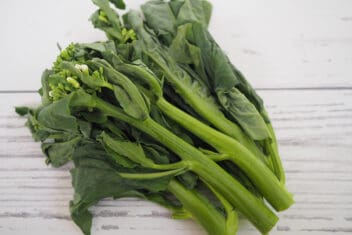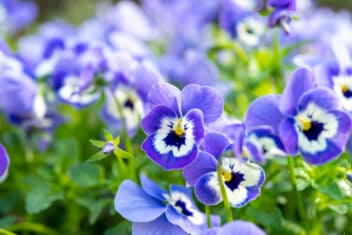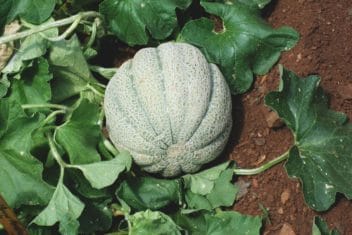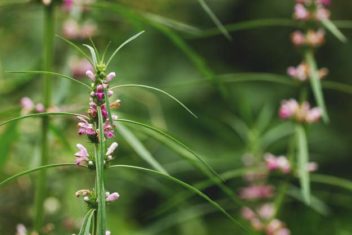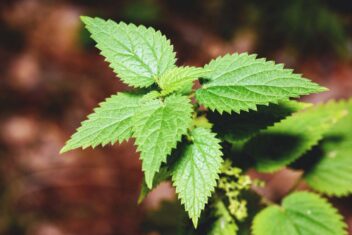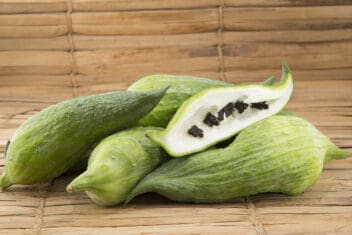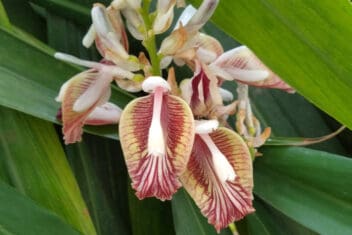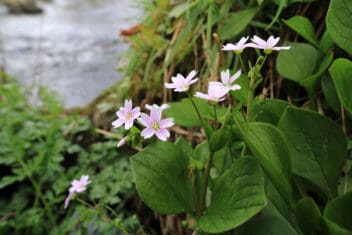Whether you do all your vegetable gardening in containers or use pots to supplement your gardens, eggplants are a fantastic vegetable to grow in containers.
That’s because you can get a large harvest from a single plant, and they add a decorative element to your patio with their deep purple fruits and beautiful flowers.
Whether you only have a tiny spot on your balcony but you want garden-fresh veggies, or you just want to make harvest time a bit easier, growing eggplants in containers is the answer. Here’s what to know.
Varieties of Eggplant That Suit Containers
Any eggplant suits container growing, but the heirloom and smaller varieties perform particularly well. Look for the word “compact” in the plant’s name.
Larger plants will grow in containers as well, but you’ll need to trellis them. Two-ring tomato cages work best.
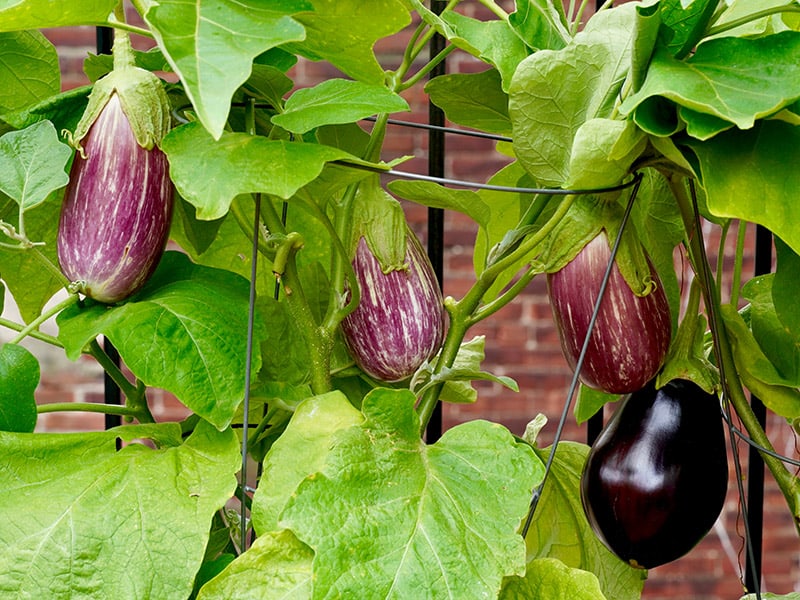
While you can plant any type of eggplant in a container, there are so many lovely, lesser-known varieties that look and taste amazing, it makes sense to try a few.
Rosa Bianca
This stunning tear-shaped eggplant is lavender and white. It’s extremely tender and creamy if you harvest when the fruits are around 5 to 6 inches. This traditional Italian type matures in just over 70 days and gets about 32 inches tall.
Long Purple
Similar in color to the standard black beauty eggplant, ‘Long Purple’ – also known as ‘Fingerling’ or ‘Long Purple Italian’ – grows long and thin. It’s an heirloom variety that can grow in as small as a 3-gallon container.
It matures in 60 days and gets up to 30 inches tall.
Little Spooky
This Japanese, all-white eggplant looks great in pots, especially among other colorful varieties such as long purple. It matures in about 60 days and gets about 3 feet tall.
Crescent Moon
‘Crescent Moon’ has a creamy, mild flavor for those who don’t like strong-tasting eggplants. About 7 inches long, the fruits are white. It gets 30 inches tall and matures in about 60 days.
Bambino
This variety is very compact, high yielding, and a quick grower. ‘Bambino’ fruits are small – about 1 inch long – dark purple to black and mild in flavor.
The plant, sometimes called ‘Patio’ eggplant, gets about a foot tall and matures in a mere 45 days – long before other varieties are ready. You can grow it in a 3-gallon container.
Fairy Tale
With long, slim purple and white fruit, ‘Fairy Tale’ has a creamy texture and mild flavor. It matures in 65 days and gets about 24 inches tall.
How to Plant Eggplant in Containers
Eggplants love sun, so find a spot with at least 6 hours of light and set up your pots. If you’re able to move them to follow the sun as the growing season progresses, your eggplant will be even happier.
Moving the pots isn’t important, however, unless you live in a cool area. If you’re able to, rotate the pot every few days to get the whole plant exposed to the sun. Eggplants like as much as they can get.
Put the plants somewhere where they won’t be hit by lots of wind, since this can break and bend branches, especially once they’re heavily loaded with fruit.
Use a good quality potting mix with loamy texture and an ability to drain well, while still retaining moisture. Don’t be tempted to use soil from your garden. This will become too compact in the pot and the eggplant will fail to thrive.
Planting Seed for Container Growing
About 8 weeks before the last frost, sow seeds inside in small pots filled with seed raising mix. Keep the soil moist with a spray bottle.
Germination takes up to 10 days. Keep moist after germination and allow to grow for another eight days or so. At this point transfer the individual plants to bigger pots.
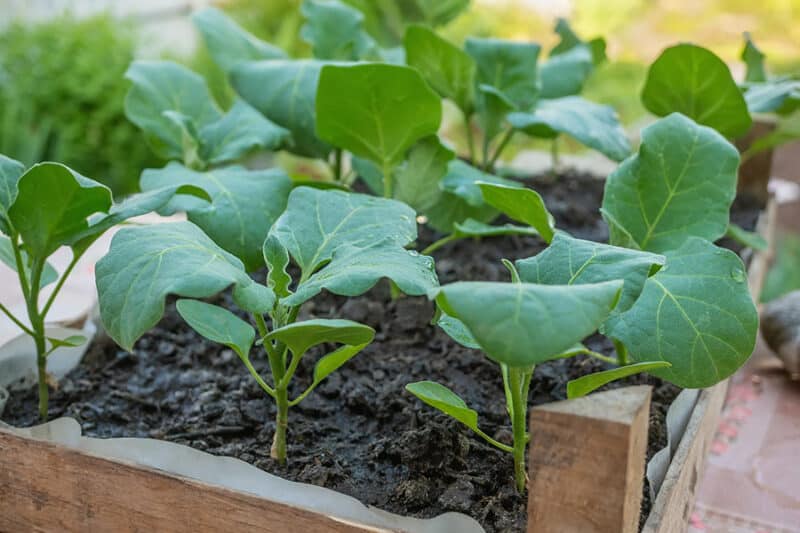
You can shock eggplant by moving it outside suddenly, so spend a little time getting the plant used to being outside after being inside all this time. Hardening off will do this.
Each day for the next two weeks, move the eggplants outside. Day one should be for an hour, day two can be a bit longer. Each day, increase the amount of time the eggplants stay outside.
Your goal here is to get the eggplant used to the outside environment. This step is important because you want the eggplant to concentrate its resources on growing it’s fruits, not trying to get used to a sudden change of temperatures.
After two weeks it’s time to plant your eggplants in their final container and to choose a sunny spot.
Planting Transplants
If you don’t want to grow from seed, you can purchase seedlings to plant into the final pot. You may need to them harden off as you would a seedling, depending on their size and if they were grown inside only.
Container Selection
Choose a container at least 4 to 5 gallons in volume. Eggplant roots need space and the ability to absorb plenty of nutrients.
I prefer to use natural materials like wood (half wine barrels are my favorite) or terra cotta. Natural materials breathe better, but I also find terra cotta pots cause the potting mix to dry out quickly. Increase your watering if you find this with your terra cotta pots.
To plant the eggplant, fill the container with potting mix and plant in a 6 to 8-inch hole. Firm down well. Most container friendly or compact eggplants don’t need staking. Tall plants may need staking or a tomato cage.
Caring for Eggplant in Containers
Eggplants growing in a container need different care than plants growing in the ground. Here’s what to know:
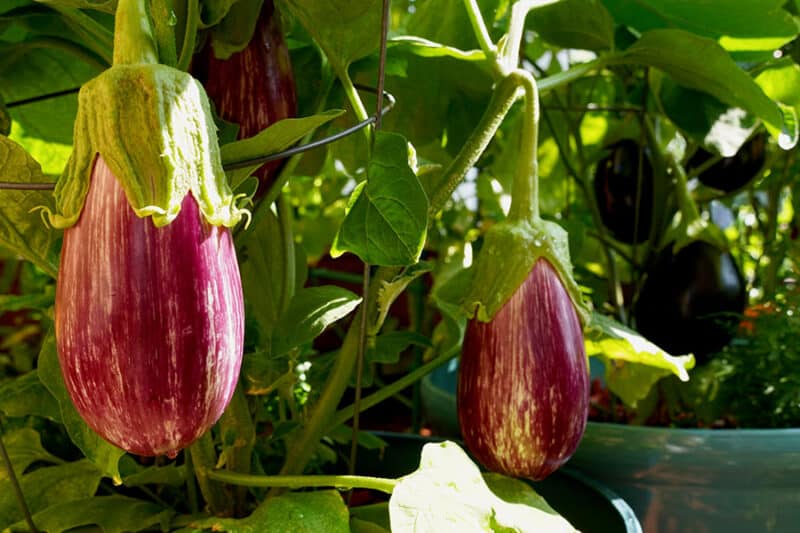
Fertilizer
Eggplants need to be fertilized well throughout the growth period right up to harvest. Many problems with eggplants are due to lack of nutrition. This is particularly common in eggplants growing in containers.
Use sustained release fertilizer pellets when you first plant the eggplant in the container. Reapply about 12 weeks later.
In between applying the sustained release fertilizer, feed weekly. Before the eggplant blossoms, use a balanced container-specific fertilizer such as a 20-20.20 fertilizer.
Once the eggplant produces flowers, switch to a fertilizer high in potassium. The easiest way to achieve this is to use a tomato fertilizer.
Water
Water the potting mix well and don’t water again until the top two inches of the medium is dry to the touch.
Pruning
I always prune eggplants because it provides for a better harvest both in number and size of individual fruit.
Ideally, you want three stems to make up the main plant. Leave the two main stems and one other. Prune the rest away, including the suckers. Remove any yellowing leaves or broken or damaged parts.
You can also prune container eggplants into a standard for a decorative touch, though you’ll get less fruit.
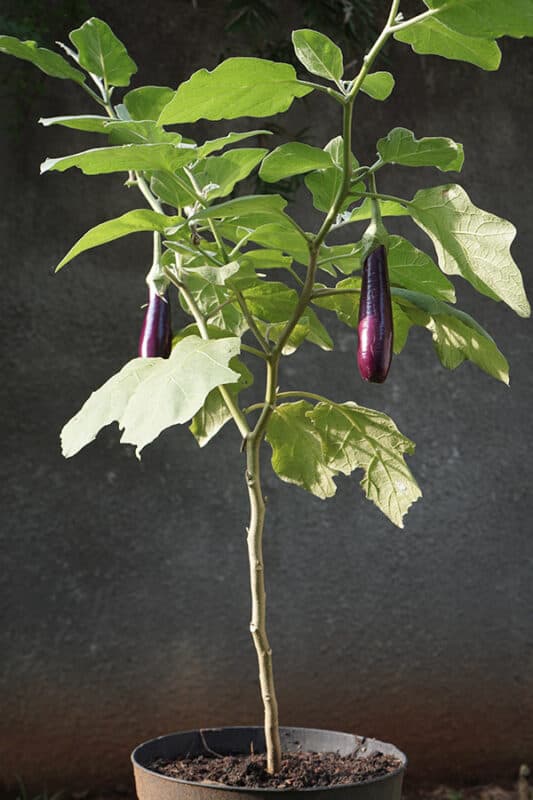
Keep an eye on the shape of the eggplant. You need good airflow through the leaves to prevent any diseases.
Companion Planting for Growing Eggplants in Pots
Herbs grow well in the same pot as eggplant. Choose herbs or flowers that tend to grow in a carpet or will hang over the side of the pot. You can grow:
Marigold also helps you deter pests like flea beetles and tomato hornworms.
Problems and Solutions for Growing Eggplant in Containers
While there aren’t as many issues you need to worry about while growing eggplant in the ground, there are a few problems that you need to watch for when growing in containers.
Black Flea Beetle
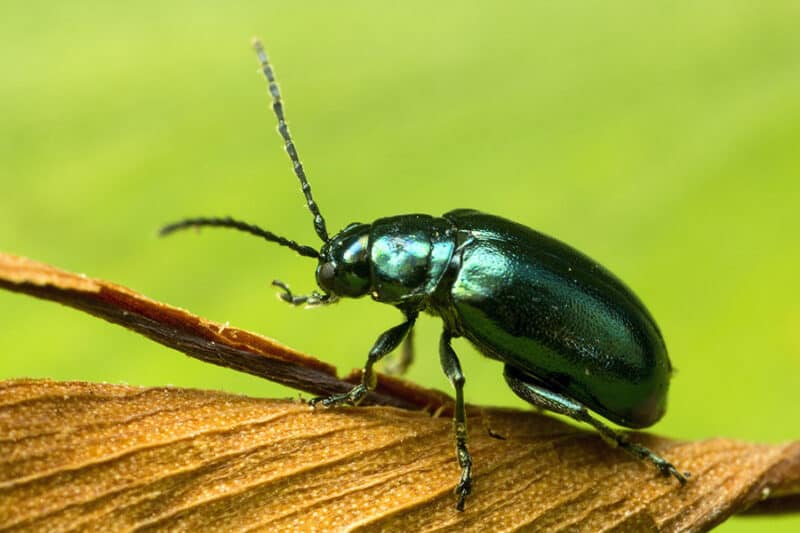
These tiny annoying insects chew holes in leaves and stems of plants. In big numbers, they cause the plant to be stunted. If their lifecycle completes in the pot, their larvae will get into the soil and attack the roots.
If you have an early-maturing eggplant that is ready in under 60 days, you don’t need to do anything to address them. If you have a slower-growing variety, use a pesticide containing spinosad or permethrin.
Ants
Ants in your pots are more about the home the ants can make in the container, rather than any damage to the eggplant itself.
There are a variety of methods to stop the ants. Raise pots on feet, use coffee grinds on the surface of the potting mix or citrus sprays or paste. Our guide will explain everything you should know.
Powdery Mildew
White powder forms on the leaves causing them to yellow and die. This causes the plant to struggle.
To prevent this, plants need plenty of air circulation. Don’t put them too close to one another or near a wall or fence. Prune to increase airflow and water at the base of the plant, not the foliage.
You can also spray plants with neem oil, either preventatively or to treat the disease.
Tomato Hornworm
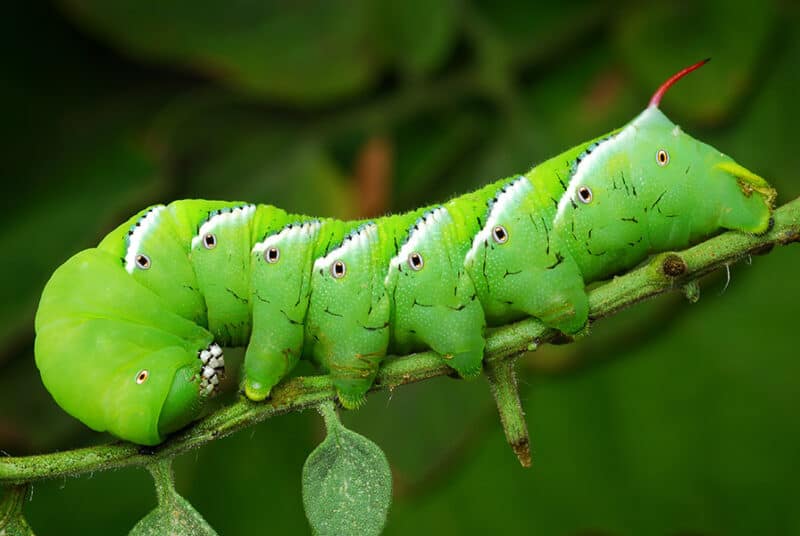
You can’t miss these insects because some get up to 5 inches long. These long green caterpillars have yellow or white stripes and a little horn-like growth at the end. They eat the leaves, usually starting at the top of the plant.
Because you’re growing in a contained space, it’s easy to handpick the insects off when you see them.
Harvesting and Using Eggplant
When the eggplant has a glossy shiny skin, it’s ready for harvesting. This can be anywhere from 45-120 days after transplanting, depending on the variety, so make sure to know how long your particular variety takes.
Simply cut the eggplant off the plant with a pair of scissors or trimmers. Be sure to pick them regularly as the eggplants mature to ensure a continuous harvest. When you pick the first fruits early, you encourage the growth of the remaining fruit.
How to Use Eggplant
Everybody has their favorite eggplant recipe (and we have lots of suggestions). From simple Italian dishes to complicated layered cheesy dishes, eggplants are versatile and well worth the effort to grow.
Part of what’s so great about them is that they take on the flavor of whatever you’re cooking them with.
However you decide to use them, it’s nice being able to grow eggplant in a container so that you can have handy, whether you live in a tiny apartment with a balcony, a giant property with room to spread.
